(No) Platypus - Penguins
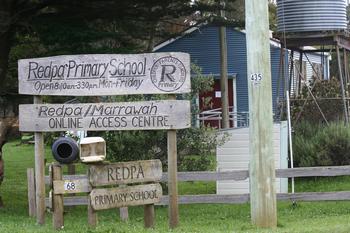 |
Last night I asked in the bar if there was an Internet cafe in town. "No" then after a pause "we have an Online Access Facility, but they don't serve lattes." It was also only open during regular business hours, so we looked for it on our way out of town in the morning. It was "Closed due to emergency dentist visit." |
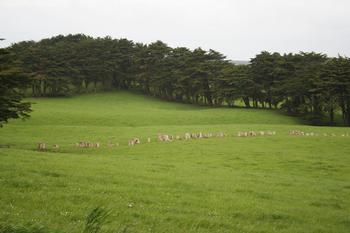 |
Onwards and upwards. Today is the last day in Tasmania, and we need to get to Launceston in reasonable time in order to find some accommodation near the airport for our early morning departure. So we plan the day: Fern Glade Park is on the way, and is famous for a good number of bird species, and more importantly for platypus spotting during daylight. Then we'll find the hotel that Wayne had spotted on the Internet but never been able to reach to make a reservation. |
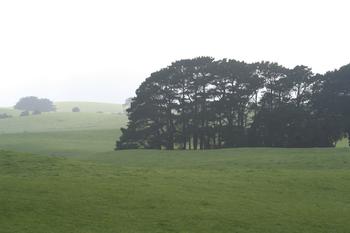 |
If we can find it and they have room terrific. If not, then we still have time to find somewhere else. Hopefully there will then be time to charge back out to the coast to do some penguin-spotting. |
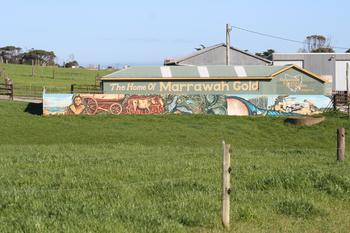 |
Whilst this looks like something you might want to smoke, in fact it turns out to be "Tasmanian Seaweed Fertiliser products [...] based on bull kelp freshly collected from the pristine rugged West Coast of Tasmania and processed the same day. This seaweed grows in what is widely recognised as the world's cleanest environment. " |
| The countryside is boring in comparison to the previous few days, but Fern Glade is lovely little park along one bank of the Emu river. There's a path along the swollen river, with signs along it to teach you about platypus habits and habitat, and how to spot them. It's a pleasant, warm, sunny afternoon, and I sit patiently by the river for a couple of hours making myself motion sick staring at the moving water while Wayne wanders up the path in search of birds. |
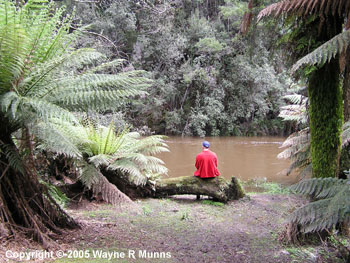 |
I study a bird sufficiently well to describe it to Wayne and identify it as one he hasn't seen yet, but I see hide nor hair of a platypus, despite a local I talked to earlier coming back to fetch me because one was frolicking where he'd been sitting. Naturally it was gone by the time we returned to his spot.
This sculpture are the entrance to the park is a solid wedge of rock about four feet long. The platypus and the water are polished to make them look wet, and the river bank is just rough hewn, but it is all the same piece of rock. |
 |
|
 |
 |
|
Platypus
Platypus are readily identified by their streamlined body, webbed feet (platypus
is Latin for "flat foot'), broad tail and characteristic bill, which is soft and
pliable. They have two layers of fur – a dense waterproof outer coat and a gray,
woolly underfur that provides much needed insulation. Males have venomous
spurs on each ankle. Their smooth swimming action, together with their low
body profile and lack of visible ears, makes them easily recognizable in the
water. Although platypus are strong swimmers, they are not fast and prefer
slow-flowing streams.
Surprisingly, platypus are capable of many vocalizations, including a soft
growling sound they make when disturbed. The female lays 2-3 round, leathery
eggs in early summer. She incubates these by holding them against her belly
with her tail as she lies in the nesting burrow. Platypus forage for food for about 12-13 hr/d, and can consume up to half their bodyweight a day. When foraging
on the bottom of waterways, platypus swim with their eyes, ears and nostrils
closed. They use their electro-sensitive bill to locate and capture a range of
prey, including worms, insects, crustaceans, mollusks and small vertebrates such
as tadpoles.
In Tasmania, platypus are common in the lakes of the Central Highlands (even in
lakes more than 914m above sea
level) and in the rivers and streams
of the south, southwest and
northwest coasts. They are shy
and wary, usually only venturing
out in the early morning and
evening. Visitors to the Fern
Glade at Burnie have a reasonable chance of seeing platypus.
Little (aka Fairy) Penguins
Little Penguins is the smallest species of penguin, and the only one to breed in Australian waters. The Bass Strait (between Australia and Tasmania is the stronghold, but they are found all along Australia's southern coast.
The birds stand about a foot tall, and weigh about two pounds. They feed on fish, mostly pilchards and anchovy, but are also partial to Gould's squid. The birds travel They travel 12 to 30 miles a day in search of the 240g of fish they need to maintain weight.
The penguins are not (yet) endangered, but the population of 60-80,000 is only about half what it was 10 years ago. The main factors in this decline are urban development, (human) fishing depleting their food sources, and the growth in dog, feral cat and fox populations. |
|
 | |
 |
|
| Then on to snap the big Penguin in the town of Penguin. There's a sea-horse farm in the area which we'd put on our radar screen, but after the platypus interlude, we're too late to catch the tour. Besides, it is somewhat against our policy of only tracking down animals in the wild.
So on to Launceston, where with our usual good fortune, we rapidly track down the hotel, it is open, they have room, and it is inexpensive. Since it is also a bar, it also has a bottle shop, and since it has a bottle shop, we buy a six pack supper. Then we head north. We drive via the airport so that we can confirm where it is, how long it takes to get there, spot the Thrifty rental return, and calculate the nearest gas station to the return. One hundred yards from the hotel is the answer to the last question, and since that is too far back, and we can't make the 60 mile round trip to the coast with what we have, we must stop for gas twice. We pull in to the next station. While Wayne pumps I find an attendant to explain the Mutton Bird Spray they are advertising. Had we looked more carefully we'd have seen that this was a "Gas and Bait" establishment. Of course. "Anglers swear fish'll grab the bait out of the air with a squirt of Mutton Bird—nice little earner, brings in $1000 a month, I reckon it must work." Group consensus is to leave this claim unchallenged, but wow, $1000 per month for fish bait seems like a lot of money.
We arrived at the coast around six (as planned) but there's a board in the parking lot which proclaims that a) the beach is private property, and b) the "tour" will start from this spot at 8:15pm. Ouch, we're earlier than we thought. Ouch, we'll have to pay. We agree that we've had good luck with guided tours so far, and we should shell out the bucks. There's a lighthouse up the hill and we waste half an hour strolling around it, but it is all closed up, so we soon repair to the parking lot and wait. Good thing we brought the beer. By 8:00 half a dozen cars have gathered when a minivan hurtles into the lot. Two young men jump out, open up the back and reveal a sort of mobile store, selling penguin souvenirs and tickets to tonight's show.
We're seriously into dusk. Someone says "don't we need to be on the beach?" Young guy number one looks at his watch and says "No worries, we have about ten minutes yet." Ten minutes? They are that punctual? It's a five minute walk down to the beach. "Watch out for the lawn mowers" number one says as he points to the sheep in the paddock we're walking through.
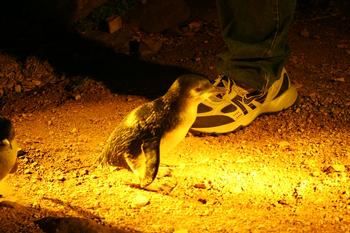 |
There's a box on the beach (a wind-break?) containing bleachers looking up the beach. We arrange ourselves on the bleachers and Number one stands at the bottom facing us. He spends a couple of minutes talking about penguins and what we're going to see, then he finishes by saying "... and about now they should be starting to assemble by these rocks." He swings his yellow-filtered searchlight over his shoulder and exactly on queue, he picks out a pair of Little Penguins standing under the rocks looking apprehensively up the beach. As we watch more heads pop up in the surf, and in a couple of minutes the are nearly a dozen birds standing clustered like extras in the wings of a theatre. Suddenly, one of them starts a dash across the 20 yards of sand, heading for the scrub we walked though on the way down. S/he hasn't taken three steps before half a dozen join in, and there is a race across the open space. By the time we've followed them with the lamp until they disappear into the bushes, there are a dozen waiting again. We can see little groups forming further up the coastline too. Apparently this will go on for several hours. |
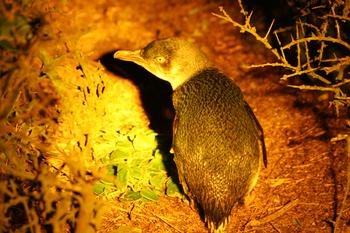 |
But we only wait for three or four groups to race across the sand, then because there are so few of us, Number one volunteers to take us into the rookery for a closer look. Indeed these are creatures of habit. Number one arranges a volunteer with one foot on a rock, and the other straddling a well worn path. A few seconds later, a penguin appears, and waddles right between his legs. And another. Provided we are not on their actual path, they ignore us completely. The yellow filter protects their sensitive eyes, and we're not allowed to use flash.
Number one does his best to provide photo ops, but obviously with a moving target in low light, it's not easy. Number one says "if you are not getting good photos, don't worry. Around the next corner is a guy who is always one of the first home, and he's happy to have his picture taken." Sure enough, round the next corner there's a penguin standing in a little clearing, looking exactly like he's waiting for us. Wayne and I have two almost identical pictures, and I'm sure everyone else in the group does too. |
The brush we're walking through, or rather around, is African thornbush. Others will later describe it as a pest, but here the dense and thorny bush which is so impenetrable that livestock owners in Africa use it as lion-proof fencing is also perfect penguin protection. The little birds, only about a foot high when they are standing tall, duck under the lowest branches and once inside are safe from any and all all their predators. |






